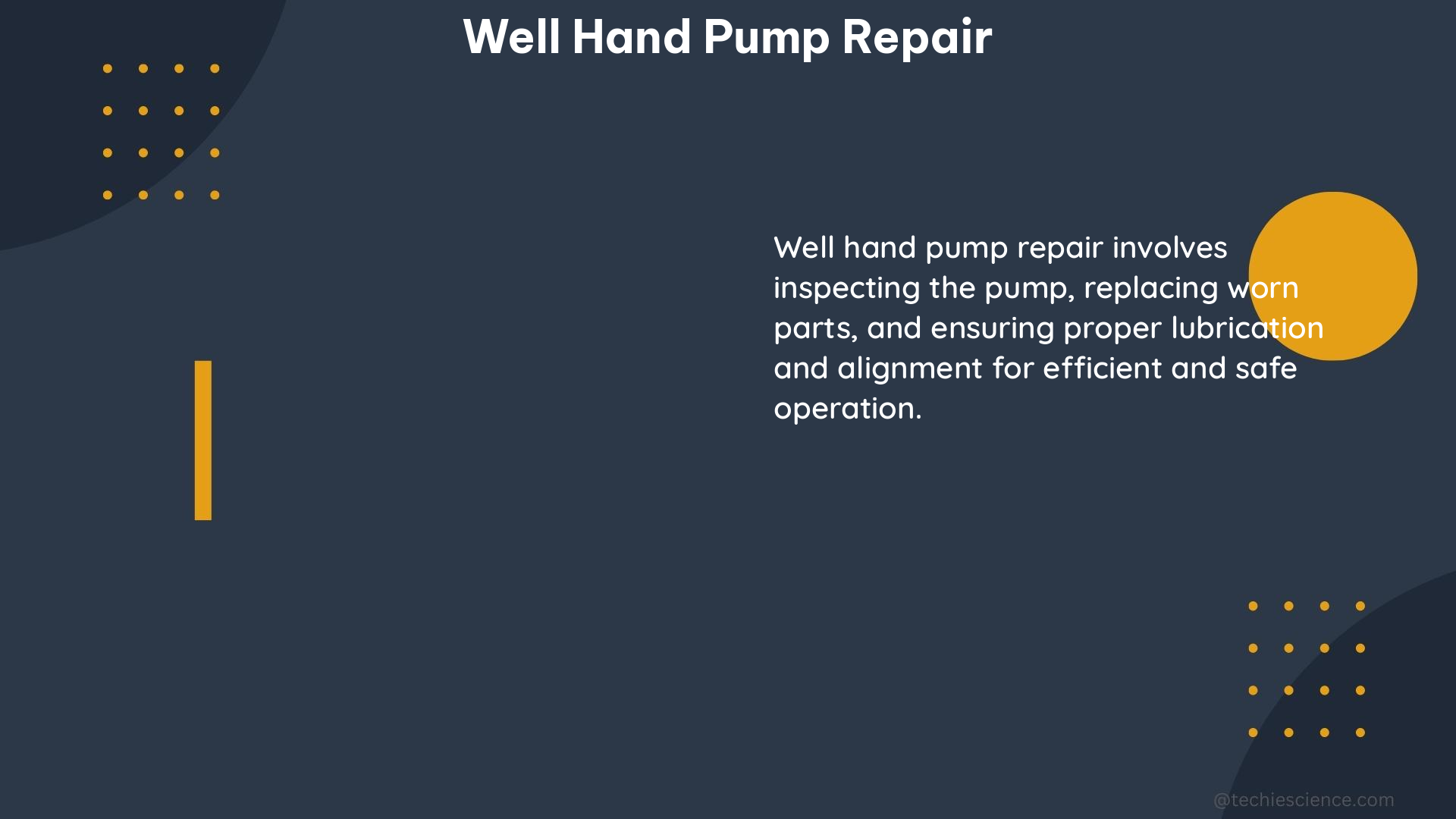Well hand pumps are a critical source of clean water for many communities around the world, but they require regular maintenance and repair to function effectively. This comprehensive guide will provide you with the technical details and quantifiable data you need to properly maintain and repair your well hand pump.
Understanding Well Hand Pump Performance
The output flow rate of a well hand pump is a crucial metric to consider when evaluating its performance. According to the Forest Service hand pump use survey, the agency’s hand pumps have an average output flow rate of 0.5 to 1.5 gallons per minute (GPM). A lower flow rate may indicate the need for repair or maintenance.
Another important factor is the sustainability of the hand pump. The Draft Guidelines for Field Evaluation of Handpump Projects provide a “sustainability snapshot” and “village handpump data” that can give valuable insights into the functionality and maintenance needs of hand pumps in a given area. These tools can help you identify potential issues and plan for preventive maintenance.
Faster Pump Repairs with Smart Handpump Technology

The Smart Handpump project has had a significant impact on the speed and efficiency of hand pump repairs. Before the project, the average repair time was 30 days. However, the project has reduced this time to less than 3 days, providing huge positive impacts on health and livelihoods.
The key to the Smart Handpump’s success is its use of remote monitoring and professional maintenance. By continuously monitoring the pump’s performance and proactively addressing issues, the project has dramatically reduced the time pumps are broken and out of service. This has resulted in more water being available to more people for longer periods.
Factors Affecting Hand Pump Sustainability
A study on the determinants of rural water handpump sustainability found that several factors can impact the functionality of a hand pump:
- Source Age: Older hand pump sources are more likely to experience functionality issues.
- Management: Effective management and maintenance practices are crucial for ensuring long-term sustainability.
- Tariff Collection: Regular tariff collection can provide the necessary funds for ongoing maintenance and repairs.
- Number of Other Sources: The availability of alternative water sources in the community can affect the demand and usage of the hand pump.
- District: The location and district where the hand pump is installed can also influence its functionality.
A Bayesian network (BN) model developed using the same data set found that the following factors have the strongest dependencies on hand pump functionality:
- Implementer: The organization or agency responsible for installing the hand pump can impact its long-term performance.
- Pump Type: Different hand pump models may have varying levels of durability and maintenance requirements.
- Management: Effective management practices, such as regular inspections and preventive maintenance, are critical for ensuring the pump’s functionality.
- Tool Availability: Having the necessary tools and equipment on hand for repairs can significantly improve the speed and quality of maintenance.
Understanding these factors can help you develop a comprehensive maintenance and repair plan for your well hand pump.
Preventive Maintenance Strategies
To ensure the long-term functionality of your well hand pump, it’s essential to implement a proactive preventive maintenance strategy. This should include:
- Regular Inspections: Conduct monthly or quarterly inspections to check for any signs of wear, damage, or potential issues.
- Lubrication: Regularly lubricate the moving parts of the hand pump, such as the bearings and seals, to reduce friction and wear.
- Component Replacement: Replace worn or damaged components, such as the pump rods, cylinders, and valves, before they fail.
- Cleaning and Disinfection: Clean the hand pump and surrounding area regularly to prevent the buildup of debris and contaminants.
- Water Quality Testing: Periodically test the water quality to ensure that the hand pump is not introducing any harmful substances.
By following these preventive maintenance strategies, you can extend the lifespan of your well hand pump and minimize the need for costly and time-consuming repairs.
Troubleshooting and Repair Techniques
When issues do arise with your well hand pump, it’s important to have a systematic approach to troubleshooting and repair. Some common problems and their solutions include:
- Reduced Output Flow: Check for blockages in the pump rods or valves, and clean or replace them as needed.
- Difficult Pumping: Inspect the bearings and seals for wear, and replace them if necessary.
- Leaks: Identify the source of the leak, such as a damaged cylinder or worn gaskets, and replace the affected components.
- Pump Failure: Assess the root cause, which could be a broken pump rod, a seized bearing, or a damaged cylinder, and replace the faulty parts.
Refer to the manufacturer’s instructions or consult a professional hand pump technician for detailed repair procedures and specifications.
Conclusion
Well hand pumps are a vital source of clean water for many communities, but they require regular maintenance and repair to function effectively. By understanding the performance metrics, sustainability factors, and preventive maintenance strategies, you can ensure the long-term reliability of your well hand pump and provide your community with a consistent and safe water supply.
References:
- Forest Service Hand Pump Use Survey
- Draft Guidelines for Field Evaluation of Handpump Projects
- Smart Handpump Project
- Determinants of Rural Water Handpump Sustainability

The lambdageeks.com Core SME Team is a group of experienced subject matter experts from diverse scientific and technical fields including Physics, Chemistry, Technology,Electronics & Electrical Engineering, Automotive, Mechanical Engineering. Our team collaborates to create high-quality, well-researched articles on a wide range of science and technology topics for the lambdageeks.com website.
All Our Senior SME are having more than 7 Years of experience in the respective fields . They are either Working Industry Professionals or assocaited With different Universities. Refer Our Authors Page to get to know About our Core SMEs.